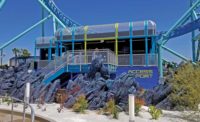High School Team Tests Skills as Roller-Coaster Builders


Seniors at the Hueneme High School Academy of Engineering and Design in Oxnard, Calif., got a chance to test their real-world engineering smarts in a project recently finished to research and build scale models of roller coasters.
The project was a contest conceived by a collaboration of the school’s English, Physics and Design departments.
The 35 students, who were separated into ten teams, researched the specifications, designed sketches of the coasters and then built them at 100:1 scale. The project gave the students an idea of what it would be like to pursue a career as an engineer.
“We were not just making a model, but a full simulation that showed how it would work in the real world. The problems we encountered: how high to make it, how much speed and force the rider experienced were the same for a real roller coaster,” said senior Alejandro Navarro.
The school’s academy is part of the National Academy Foundation, a network that offers targeted engineering and other specialties to high school students in underserved areas.
In a partnership between the Foundation and Kelly Services, the roller coaster project was selected to receive a grant from the recruiting company based on a number of factors, from innovation and originality to the impact it will have on the local community. Julie Spear, staffing supervisor, spoke about Kelly Services’ hopes for the outcome of the project.
“Kelly likes to support projects that stimulate the interests of students to pursue a secondary education in a STEM field of study," says staffing supervisor Julie Spear. "We hope to help these students from urban and low-income areas to pursue higher education and encourage career interest in the critical IT, engineering and finance disciplines.”
The grant provided the students with new LabQuest2 data collection devices and wireless accelerometers, which allowed for more precise research in a field trip to Six Flags Magic Mountain amusement park in Valencia, Calif.
“Using this new technology we were able to record highly detailed data from several of the roller coasters, making real time graphs of height and acceleration in three axes,” says science teacher Jay Robnett.
The roller coasters were judged on originality of the ride’s theme, ride safety and the skill used to build the model. The winners will be awarded a certificate at the academy’s senior awards night in May.




